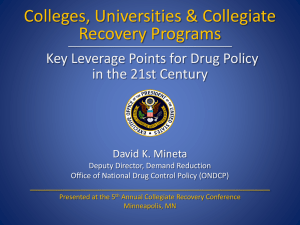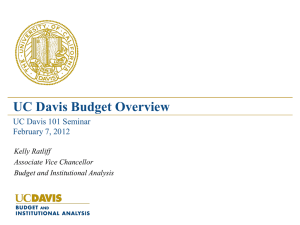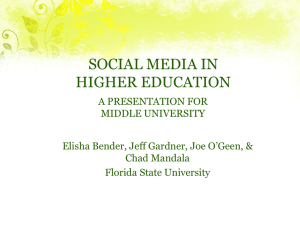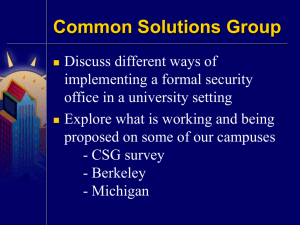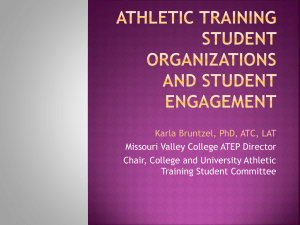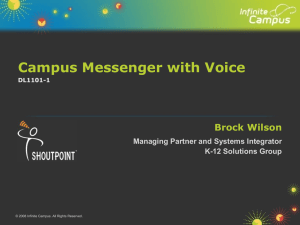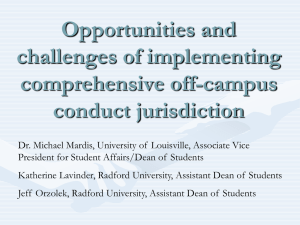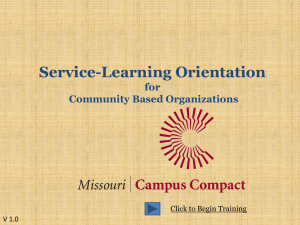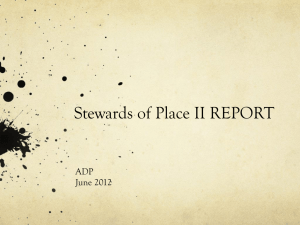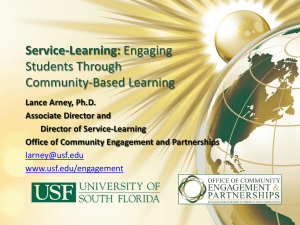Arkansas Tech University (porter)
advertisement
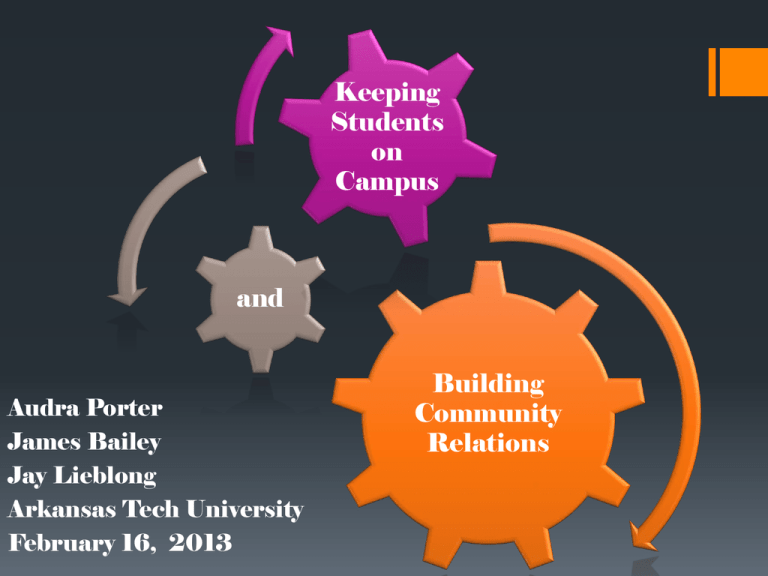
Keeping Students on Campus and Audra Porter James Bailey Jay Lieblong Arkansas Tech University February 16, 2013 Building Community Relations Goals Keep students on campus Build community relations Market Extending the hours of the campus coffee shop and select dining establishments to allow for 24-hour student access Reduce the amount of traffic in town through University Transit Social media Hosting late-night, on-campus activities Require Freshmen to remain pedestrians until Sophomore year Community website Using an existing campus structure, create a campus bar Host events at a convention center Host alcohol-friendly campus events Creation of a Civic Engagement Department Implement Service Learning Ecology Theory Recognizing that environments shape human behavior, we must make the most of the space and existing services we have. A 24-hour coffee shop on campus with comfortable seating and 24-hour food options would encourage students to stay on campus late at night instead of heading out in town. Existing spaces can be redesigned to bring people together (Schuh, et al., 2011). An assessment could measure GPA levels, degrees granted, and student contributions to the workforce, to demonstrate the effectiveness of our program. Offering late night campus events that ended upwards of 3 am such as movies, games and sporting activities would also encourage students to stay on campus (Student Affairs Leader, 2006 ). Benefitting the institution, ecological theory and environmental assessment can contribute to institutional efficacy in retaining and graduating diverse students (Schuh, et al., 2011). Campus Bar Establishment Allowing an on-campus bar would eliminate many of the problems we are addressing. Not only would we take the rowdy students away from disrupting the community, but we would also keep them safer in a controlled environment. An oncampus bar would help regulate their drinking compared to off-campus parties. In a controlled environment, we can eliminate alcohol as the exclusive activity by introducing food, games, and other forms of entertainment (Paschall & Saltz, 2007). Most of the research that has been conducted will show that students drink more off-campus than on-campus and at other campus events (Voas, Johnson, Turrisi, Taylor, Honts, & Nelsen, 2008). Other campuses that have tried to implement alcohol on campus noticed an increase in the beginning of drinking, but it quickly lowered to less than non-alcoholic campuses. This graph shows the number of drinks consumed before, during, and after several different events. It also breaks it up to show the difference between under 21 (illegal) and over 21 (legal) drinkers. In the graph, both groups drink more during off-campus events which has been linked to several of our problems: noise, drunk driving, unmonitored drinking, etc (Paschall & Saltz, 2007) This graph shows the percent of students who drank 5+ drinks in the past two weeks (top) and the amount of times drunk past 4 weeks (bottom). TU is the Transition University. This University was allowing alcohol oncampus during activities under the dates listed to see how it affected drinking patterns. CU is the Control University. This University was a sister school to the TU. It shows what would presumably have been happening at the TU if the transition did not take effect. Both the top and bottom show an incline in the first few semesters, but by the end of the data TU is lower in both categories (Voaz et al., 2008). Campus Bar Establishment Redesigning a structure to incorporate an establishment that serves alcohol on campus and stays open until 2 am will prevent students from leaving campus to drink, reducing drinking and driving in the surrounding town. Examples of college campuses with bars include: Vassar College, Middlebury College, Trinity College Cambridge, and Colorado State University. Offering and allowing alcohol at university events could bolster attendance at our events and reduce the number of students traveling off-campus to drink, followed by driving under the influence back to campus to attend our events. Texas A&M University has implemented this successful program and has no thoughts of removing it (McLean & Harris, 2012). This is a proven method of preserving tradition, but allowing for innovation for the changing demographics of the student population. Build Community Relations Have monthly think tank committee meetings to assess community standards, the effectiveness and popularity of the plans we are implementing, and to brainstorm on new ideas to build community relations between the school and town. We propose to create a Civic Engagement department in our Student Life division to seek out volunteer opportunities in the surrounding community. We will make graduate assistant, work-study, and service learning opportunities available to students. Incorporating this video from George Washington University into our freshmen orientation presentation will serve as comedic relief for the students and also introduce students to the idea of respecting the surrounding culture of our university. •Good Neighbor Video: We Are Not Alone University Transit Implementing a university transit system will be beneficial to our university and the surrounding town. The system will potentially reduce number of students walking off-campus, require fewer students to have their own transportation, thus reducing the amount of traffic on and off-campus, and late night service will reduce the number of students drinking and driving. Reducing the number of students driving under the influence is of great importance: https://www.youtube.com/watch?v=4B_rbmOrhGM University transit could also serve to shuttle students to and from school-wide events held off-campus. Holding large university events at convention centers rather than on-campus will reduce the amount of off-campus traffic and nuisance to the surrounding community. University Transit Some universities that have two or more geographically separate campuses require a transportation system. University transit systems are usually only for use by students, faculty, employees, and visitors with passes, and are not available used as public transportation. Examples of universities with university transit systems include East Carolina University (located in North Carolina), University of Arkansas- Fayetteville, University of Kentucky, (American Public Transportation Association, 2013). In an arrangement between universities and U.S. public transit agencies called Unlimited Access, fare-free transit service is offered for all students (and, on some campuses, faculty and staff as well). The university pays the transit agency for all rides taken by eligible members of the campus community. According to an evaluation by Brown, Hess, and Shoup, 2003, the results of the Unlimited Access program at the University of California, Los Angeles (UCLA), “bus ridership for commuting to campus increased by 56 percent during the program’s first year, and solo driving fell by 20 percent. Because these startling results were achieved in a city famous for its addiction to cars, they suggest that Unlimited Access can succeed almost anywhere.” Pedestrian Freshmen Not allowing freshmen to have vehicles on campus would, again, alleviate traffic on and off-campus. Freshmen could rely on the university transit to get them on and off-campus. An assessment could measure retention rates from freshmen to sophomore year before and after the plan was implemented. Town businesses could still flourish by servicing our university in various capacities: Community crafts could be sold in our bookstore Some screen-printing/ embroidery could be done by boutiques for university clothing Local restaurants could cater for our events Addressing campus events Finding a new location such as the nearest hotel and convention center to host large events at will decrease the need for there to be so many people invading the town. Utilizing our shuttle service to escort students back and forth to events that involve alcohol can reduce driving under the influence. (Virginia Beach Convention & Visitors Bureau, 2012) Service-Learning College students around the country are participating in service-learning projects in record numbers. “Community service-learning can be characterized as a form of experiential education in which students combine the carrying out of needed tasks in the community with intentional learning goals and with conscious reflection and critical analysis.” The effects of the service-learning research performed by Ignatius University’s philosophy department was a positive experience but one group produced better results. Two college student groups were formed to find out if working with the youth or working with older adults in the community had a positive lasting result or not. Over 200 studies said that the effects of community service-learning of college students have been positive, but working with adult learners rated as more rewarding to the college students than working with the youth. This was based on a qualitative measurement of how the students felt after the experience. The reason for the difference was found to be the college students lofty expectations of making a significant contribution or change in a youths life. After the trial was over they did not feel as rewarded as they thought they would. Another debate that arises is weather or not the working conditions should be mandatory or structured. The findings suggest that students that engage in more than 20 hours a week of service-learning achieve a greater awareness of social issues and a deeper commitment to community involvement (Seider, Rabinowicz & Gillmor, 2012) Greening the Economy Through Service-Learning According to the research conducted by Ignatius University, environmentalism is one of the top servicelearning passions of todays college student. Robert J. Koester the director of the Center for Energy Research/Education Service (CRES) says that a major misconception is shifting technologies would suggest new skills and different business models but Koester says that much of alternative sourcing of energy, energy conservation, and delivery-system management involves nothing more than repurposing existing skill sets. “It is an alternative expression of the current manufacturing capacity.” Colleges and universities are institutional settings that operate like that of a community, city, or small town. A lot of campuses have over 10,000 students and have their own infrastructure that operates much like a city. “The students and citizens participating in a well-structured campus and community interaction can adopt the modeled values as a bridge to lifelong adult learning” (Koester, 2013). Greening of the economy simply put is the future of the economy brought about by a shift from the use of fossil fuels to renewable-resource-based energy; a shift that can start with students and have positive effects on communities. Helping the Nation with Service Learning and Greening the Economy Why universities are the best place to succeed in greening of the economy: College campuses have an infrastructure like cities and towns Most of the Universities employ from the community and in turn what changes are made to the university by students and staff is service-learning. Students are tasked with implementing new programs and working along side university staff (members of the community) to retool the Universities power supply, water consumption, waste, refurbishing the grounds with recycled or reusable waste, and countless other green economic upgrades. The knowledge that is gained by the students and staff will transform the local community as well. College campuses have ownership, and their own policies that enable them to integrate planning and operations with education more than most corporations or communities At its very nature of formal organization, problem identification, policy development, and integrated action, the university setting is a great platform for partnership and vision (Koester, 2013). It is the perfect set up when over 350 university presidents and chancellors in more than 40 countries signed the Tallories Decleration. Ball State University Became a signatory to the Tallories Declaration in 1999, a ten point action plan for incorporating sustainability and environmental literacy in teaching. Today Ball State University has a Council On The Environment (COTE). This council consists of a member of each of the academic colleges of the university, student body, and the local Muncie community. Its mission is to provide “leadership for initiatives at Ball State University and community that promotes sustainable use of natural resources and the protection of ecological systems that sustain life.” We think that a University should embody the ideals and consider modeling their service-learning projects based on the models created by Ball State University, students and Muncie community. Marketing The University of North Carolina- Wilmington developed a website for students preparing to move, or already are living, off campus. UNCW’s PERCH is designed to teach students community standards, show affordable property off campus, and bring roommates together. Message boards are provided so students can converse about local happenings.. We want to propose an engaging student/community relations with an educational website for off campus students. Made for students living off campus or students preparing to move off campus, to learn about life outside the university. On the site we would bring forums for non-student residents, law enforcement, and students to discuss disruptive behavior and other neighborhood issues and guidelines. Using social media such as Facebook, the university’s Twitter feed, and the university calendar to market community outreach programs is an easy way to reach students and bolster student involvement at local community events. References American Public Transportation Association. (2013, February 09). University transit. Retrieved from http://www.apta.com/resources/links/Pages/USUniversityTransit.aspx Andrews, P. (2013). Ramskeller. Retrieved from http://www.sc.colostate.edu/ramskeller.aspx Brown, J., Hess, D. B., & Shoup, D. (2003). Fare-free public transit at universities: An evaluation. Journal of Planning Education and Research, 23, 69-82. doi: 10.1177/0739456X03255430 Chapman, R. J. (2007). On-campus taverns: A look at the pros and cons of operation. Informally published manuscript, Behavioral Health Counseling Department, Drexel, Philadelphia, PA, Retrieved from http://www.robertchapman.net/essays/taverns.pdf Designing Late-Night, Substance-Free Student Events. (2006). Student Affairs Leader. 34(13). 6. East Carolina University. (2013, January 09). Ecu transit. Retrieved from http://www.ecu.edu/cs-studentlife/transit/ Koester, R. (2013). Higher education, adult learning, and greening of the economy.. Adult Learning, 24(1), 37-42. doi: 10.1177/1045159512467777 McLean, C., & Harris, G. (2012, November). Cultivating tradition-based programming for a changing student population. Presentation at Southern association for college student affairs, Memphis, TN. Middlebury College. (2013). Middlebury college catering options. Retrieved from http://www.middlebury.edu/offices/business/scheduling/caterers Online Universities. (2013, February 09). 10 campuses with the best public transportation. Retrieved from http://www.onlineuniversities.com/rankings/10-campuses-with-the-best-public-transportation/ Paschall, M. J., & Saltz, R. F. (2007). Relationships between college settings and student alcohol use before, during and after events: a multi-level study. Drug & Alcohol Review, 26(6), 635-644. doi:10.1080/09595230701613601 Saltz, R. F., Welker, L. R., Paschall, M. J., Feeney, M. A., & Fabiano, P. M. National Center for Biotechnology Information, National Institute for Health. (2009). Evaluating a comprehensive campus-community prevention intervention to reduce alcohol-related problems in a college population. Retrieved from website: http://www.ncbi.nlm.nih.gov/pmc/articles/PMC2701100/ Schuh, J.H., Jones, S.R., Harper, S.R., and Associates (5th ed.). (2011). Student services: A handbook for the profession. San Francisco, CA: Jossey-Bass Publishers. Seider, S., Rabinowicz, S., & Gillmor, S. (2012). Differential outcomes for american college students engaged in community servicelearning involving youth and adults. Journal of Experiential Education, 35(3), 447-463. Doi 10.5193/JEE35.3.447 Texas A&M University. (2013). Responsible tailgating. Retrieved from http://tailgating.tamu.edu/rules.html Trinity College Cambridge. (2013). College bar. Retrieved from http://www.trin.cam.ac.uk/index.php?pageid=50 University of Arkansas- Fayetteville. (2013). Transit and parking. Retrieved from http://parking.uark.edu/ University of California- Los Angeles. (2013). Unlimited access. Informally published manuscript, Institute of Transportation Services, University of California- Los Angeles, Los Angeles, CA, Retrieved from http://www.its.ucla.edu/research/UA/index.cfm University of Kentucky. (2013). Buses & shuttles. Retrieved from http://www.uky.edu/pts/buses-and-shuttles University of North Carolina- Wilmington. (2013). Perch. Retrieved from http://www.uncw.edu/PERCH/ Vassar College. (2002). Matthew's mug: The groove is in the heart. Vassar: The Alumnae/i Quarterly, 98(2), Retrieved from http://vq.vassar.edu/issues/2002/02/vassar-today/matthew-mug.html Virginia Beach Convention & Visitors Bureau. (Photographer). (2012). Virginia beach convention center. [Web Photo]. Retrieved from http://www.visitvirginiabeach.com/conventioncenter/ Voas, R. B., Johnson, M., Turrisi, R. J., Taylor, D., Honts, C., & Nelsen, L. (2008). Bringing alcohol on campus to raise money: impact on student drinking and drinking problems. Addiction, 103(6), 940-950.

